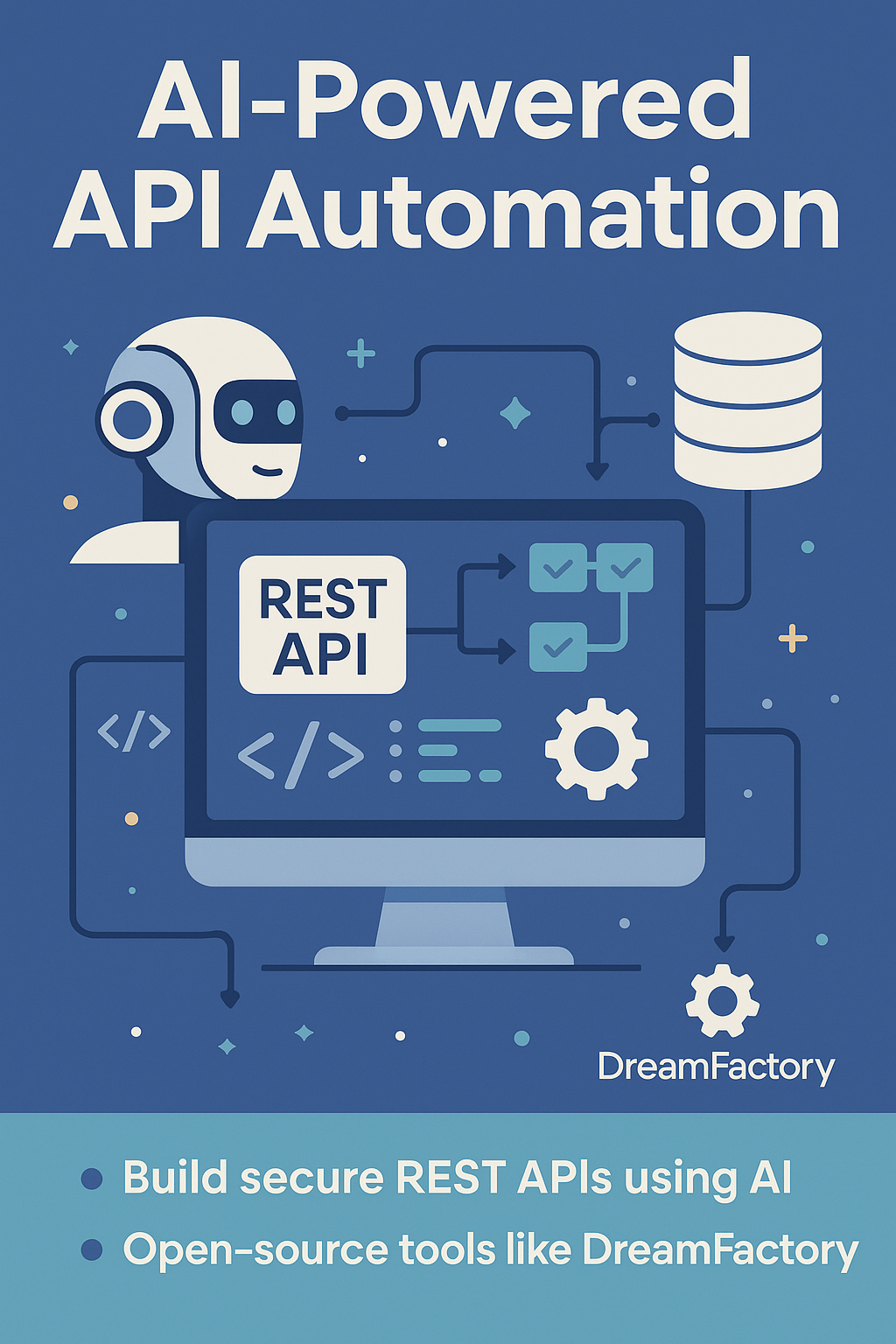Modern innovation demands fast, secure, and flexible access to data. But when organizations deal with scattered databases and strict security policies, manual API development slows everything down. The solution? Automate how APIs are built, secured, and managed—using AI and open-source tools like DreamFactory.
Why API Automation Matters
Creating secure REST APIs by hand is time-consuming and error-prone. Developers must connect to databases, write middleware, enforce security, and document everything. Every new data source increases complexity.
AI-powered API automation removes this friction. Instead of writing custom code for every endpoint, developers can:
- Choose a data source
- Define access controls
- Let the platform auto-generate secure REST APIs
This speeds up delivery, reduces human error, and strengthens security across distributed systems.
Meet DreamFactory: The AI-Ready API Platform
DreamFactory is an open-source API generation platform built on Laravel. It supports automated REST API creation for nearly any backend system with built-in security, documentation, and customization.
Key features include:
- Instant API Generation: Connect a data source → click → generate REST API.
- Live Swagger Docs: Every endpoint includes live, auto-synced OpenAPI specs.
- User & Role Management: Built-in support for RBAC, OAuth2, and API key issuance.
- Flexible Scripting: Add pre/post logic in PHP, Python, or NodeJS.
- Cloud-Native Deployment: Run on-prem, Docker, or Kubernetes clusters.
Here's a table summarizing how DreamFactory stacks up compared to traditional manual API development:
|
Feature |
Manual Coding |
DreamFactory |
|---|---|---|
|
API Generation Time |
Days to weeks |
Minutes |
|
Built-in Security |
Custom logic needed |
Predefined (RBAC, OAuth) |
|
API Documentation |
Separate process |
Auto-generated (Swagger) |
|
Scripting/Customization |
Write middleware |
Simple script plugins |
|
Data Source Support |
Custom connectors |
Broad (SQL, NoSQL, storage) |
|
Deployment |
Resource intensive |
Lightweight, flexible |
The Role of AI in API Security and Management
A modern API platform needs to do more than authenticate users—it must actively defend itself.
Core must-haves include:
- Authentication Enforcement: OAuth2, JWT, and API key validation
- Dynamic Role Handling: Instantly adapt permissions as orgs evolve
- Threat Protection: Detect SQL injection, XSS, and suspicious inputs
- Live Monitoring: Track usage, patterns, and outliers in real time
This is where AI becomes indispensable.
AI-powered platforms continuously analyze API traffic to detect anomalies—like spikes, irregular patterns, or repeated access failures—before they escalate into breaches. Whether it’s a misconfigured token or an active threat actor probing endpoints, machine learning spots what rule-based systems miss.
Smart auditing goes further—automating logs, role reviews, and access histories to simplify compliance with frameworks like GDPR and HIPAA. The result: security and assurance, without drowning in manual checks.
Real-Time Documentation = Better Developer Experience
Few things derail developer velocity faster than out-of-date or missing API docs. The better path? Documentation that writes itself.
AI-augmented platforms deliver:
- Accuracy by Default: Docs update automatically with every endpoint
- Onboarding Efficiency: Developers can explore, test, and ship without email threads
Platforms like DreamFactory auto-generate OpenAPI (Swagger) specs as soon as new services are published. Built-in consoles allow both internal and external devs to experiment with live endpoints—removing the guesswork.
This "documentation by design" model ensures every integration is secure, discoverable, and current.
Adaptive Endpoint Customization
While low-code and no-code options are ideal for speed, real-world APIs often need a bit more nuance—validation rules, transformation logic, or downstream triggers.
A flexible API platform should support:
- Pre-Request Scripting: Enrich requests or validate inputs
- Post-Process Hooks: Trigger emails, log events, or modify responses
- Multi-Language Scripting: Use PHP, Python, or NodeJS based on your stack
DreamFactory lets you embed this logic directly in the admin panel—no need to recompile or redeploy. This empowers teams to move fast without compromising on custom workflows or security posture.
Deployment That Matches Your Needs
Every org has different constraints:
- Startups want fast cloud deployments
- Enterprises need on-prem control
- Platform teams may favor Kubernetes for portability
A modern API platform should:
- Offer native Docker images for quick deployment
- Support Helm charts and operators for K8s environments
- Run on-prem or on commodity hardware with no vendor lock-in
DreamFactory supports all of the above. Whether you're running a private healthcare stack or migrating workloads to the cloud, your API layer moves with you.
AI-Driven User and Role Management
API security isn’t just about endpoints—it’s about who can reach them.
AI-enhanced admin tools now help:
- Recommend least-privilege roles based on usage patterns
- Simplify privilege audits and role updates
- Integrate with LDAP, Active Directory, or OAuth providers
|
Security Feature |
Manual Configuration |
AI/Automated Management |
|---|---|---|
|
User provisioning |
Risk of oversights |
Guided/process-driven |
|
Privilege audits |
Resource-intensive |
Recommendations/auto-review |
|
Role updates |
Prone to error |
Pattern-based suggestions |
|
Compliance reporting |
Piecemeal/manual |
Centralized, on-demand |
The AI layer doesn’t replace human judgment—it amplifies it. Admins stay in control, but with smarter tools and less friction.
Unified Access Across Mixed Backends
APIs often sit between chaos and clarity. One team uses MySQL. Another prefers MongoDB. A third needs S3 or Azure Blob for reports.
Unified API layers solve this by abstracting the complexity. Developers interact with clean REST endpoints—regardless of the underlying data source.
AI-driven schema mapping even recommends:
- Optimal joins and aggregations
- Composite endpoints for complex queries
- Data normalization across formats
DreamFactory supports a huge array of backends: SQL, NoSQL, file storage, email, and more. Adding a new source takes minutes—not days.
Real-Time Monitoring and AI Insights
Deployment is just the start. Ongoing visibility is how you stay ahead of incidents.
AI-native dashboards surface:
- Latency spikes and high-error endpoints
- Usage breakdowns by user, region, or app
- Suspicious auth attempts and access anomalies
This level of operational intelligence helps teams troubleshoot faster, scale smoother, and catch subtle issues before they explode into outages.
Scripting for Customization and Integration
No automation platform can predict every edge case. That’s why API-level scripting is key.
Use lightweight scripts for:
- Reformatting payloads (e.g., date conversion)
- Enforcing dynamic rate limits or access quotas
- Sending notifications (Slack, SMS, webhook)
- Logging and exporting to SIEM/SOC platforms
These scripts live within the API layer itself, instantly modifiable, and don’t require rewriting your backend. Small bits of logic, massive gains in flexibility.
The Future: AI-Augmented API Lifecycles
AI doesn’t just plug into one part of the API lifecycle—it transforms all of it:
- Build faster with auto-docs and prebuilt connectors
- Secure better with anomaly detection and smart RBAC
- Adapt instantly with flexible logic and AI-backed decisions
- Maintain seamlessly with self-healing monitoring and insights
Platforms like DreamFactory are showing how an AI-augmented foundation leads to speed, safety, and scale—without sacrificing clarity or control.
Whether you're building internal tools, mobile apps, or partner-facing APIs, the new API lifecycle puts intelligence and automation front and center.
Terence Bennett, CEO of DreamFactory, has a wealth of experience in government IT systems and Google Cloud. His impressive background includes being a former U.S. Navy Intelligence Officer and a former member of Google's Red Team. Prior to becoming CEO, he served as COO at DreamFactory Software.
























 Blog
Blog

